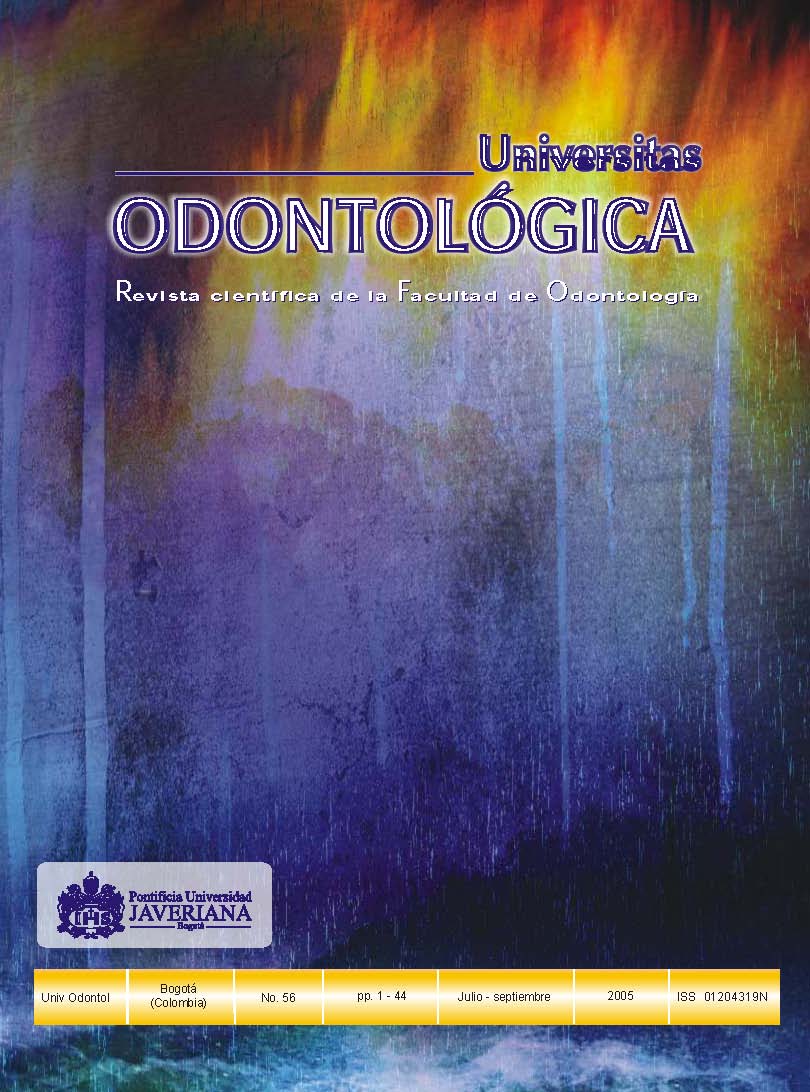Resumo
ANTECEDENTES: El láser Er:YAG produce un efecto de grabado en esmalte sin requerir el uso de un agente químico; se desconoce el patrón de grabado que genera sobre la superficie dental.OBJETIVO: Identificar sí existen diferencias entre los patrones de grabado producidos con láser Erbio:YAG y/o con ácido ortofosfórico al 37%, por medio de microscopía electrónica, para determinar sí el grabado producido con láser requiere el uso de un agente químico o no. METODOS: para éste estudio experimental in vitro, se utilizaron tres dientes en una fase prepiloto (estandarización) y una muestra de 15 dientes para el eestudio piloto. Los 18 dientes se asignaron a tres grupos, los cuales fueron sometidos a grabado con láser, ácido ortofosfórico al 37% y láser combinado con ácido, siguiendo las indicaciones de los fabricantes. Criterios de inclusión: premolares postexodoncia y caries poco extensas. Criterios de exclusión: personas que estuviera en desacuerdo con el consentimiento informado. Mediante la prueba de Chi cuadrado fué probada la hipótesis de investigación. RESULTADOS: en el grupo de láser Er:YAG se observó un patrón de grabado con características similares al tipo I el grupo de ácido ortofosfórico al 37% presentó una aumentada frecuencia de patrón tipo II y en el grupo láser Er:YAG, ácido ortofosfórico al 37% se observó un de patrón tipo I. CONCLUSIONES:el láser Er:YAG logra un patrón de grabado similar al tipo I y requiere del uso de un agente químico cómo el ácido ortofosfórico añ 37%, para crear una disolución completa del núcelo prismático.
BACKGROUNDS: erbium YAG laser produces an effect of enamel etching without using a chemical agent; the etching pattern produced with Erbium YAG laser and/or with 37% orthophosphoric acid, and laser mixed with acid, following manufacturer´s instructions. Inclusion criteria: premolar postexodontia and not very with tooth cavity. Exclusion criteria:people disagree with the informed consent. Research hypothesis was approved applying the Chi Square test.RESULTS: in the group of Erbium YAG laser the etching pattern had characteristics similar ti type I; in the group of 37% orthophosphoric acid had higher frequency on pattern type II, and in the group of Erbium YAG laser plus 37% orthophosphoric acid had a pattern type I. CONCLUSIONS:erbium YAG laser has an etching pattern similar to type I and requires a chemical agent such as 37% orthophosphoric acid to create a complete disolution of the prismatic nucleus.
España Tost A. Láser de Er:YAG en odontología. Oper Dent Endod 1998; 2(2): 10.
Miserendino L et al. Lasers in dentistry. Quintessence Books.Singapore. 1995; 17-24.
Ceballos L. et al. Microleakage of composite restorations after acid or Er:YAG laser cavity treatments. Dent Mater 2001; 17: 340-6.
Thomé M et al. SEM evaluation of the interaction pattern between dentin and resin after cavity preparation using Er:YAG laser. J Dent 2003; 31: 127-35.
Wigdor H et al. The effect of lasers on dental hard tissues.JADA, vol. 24, February 1993; 65-70.
Ceballos L et al. Bonding to Er:YAG laser treated dentin. JDent Res 2002; 81(2): 119-22.
Miserendino L et al. Lasers in dentistry. Quintessence Books.Singapore, 1995; 161-4.
Guzmán HJ. Biomateriales odontológicos de uso clínico. 2a ed. Colombia. COE Ediciones, 1999; 300-1.
Franchi M et al. Effects of acid-etching solutions on human enamel and dentin. Quintessence Int 1995; 26: 431-5.
Hanning M, Reinhardt KJ. Self etching primer vs phosphoric acid: an alternative comcept for composite-to-enamel Bonding. Oper Dent 1999; 24, 172-80.
Jennett E et al. Dye enhanced ablation of enamel by pulsed lasers. J Dent Res december, 1994; 73(12): 1841-7.
Natera A et al. Usos del rayo láser de erbium:yag (Er:YAG) en odontología restauradora. II parte. Acta odontológica 2002; 40(2).
Blomlöf J et al. A new concept for etching in restorative dentistry. Int J Periodontics Restorative Dent 1999; 19: 31-5.
Swuift E et al. Bonding to enamel and dentin: a brief history and state of the art, 1995. Quintessence Int 1995; 26: 95-110.
Lee Ch et al. Microscopic appearance of enamel whitespot lesions after acid etching. Quintessence Int 1995; 26:279-84.
Glasspoole E et al. Effect of enamel pretreatments on bond strength of compomer. Dent Mater. September 2001; 17(5):402-8.
Martínez A et al. Differences in bonding to acid etched or Er:YAG laser-treated enamel and dentin surfaces. J Prosthet Dent 2000; 84: 280-8.
Sazak H et al. Effects of Nd:YAG laser, air abrasion and acidetching on human enamel and dentin. Oper Dent 2001;26: 476-81.
Arigaratnam M et al. A comparison of surface roughness and composite/enamel bond strength of human enamel following the application of the Nd:YAG laser and etching with phosphoric acid. Dent Mater January 1997; 13: 51-5.
Corpas L et al. Comparing the tensile strenght of brackets adhered to laser-etched enamel vs acid etched enamel. JADA, June 1997; 28.
Este periódico científico está registrado sob a licença Creative Commons Atribuição 4.0 Internacional. Portanto, este trabalho pode ser reproduzido, distribuído e comunicado publicamente em formato digital, desde que os autores e a Pontifícia Universidade Javeriana sejam reconhecidos. Citar, adaptar, transformar, autoarquivar, republicar e criar novas obras a partir do material é permitido para qualquer finalidade (mesmo comercial), desde que a autoria seja devidamente reconhecida, um link para o trabalho original seja fornecido e quaisquer alterações sejam indicadas. A Pontifícia Universidade Javeriana não detém os direitos sobre os trabalhos publicados, e o conteúdo é de exclusiva responsabilidade dos autores, que mantêm seus direitos morais, intelectuais, de privacidade e de publicidade.


